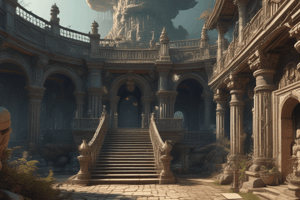Podcast
Questions and Answers
Which 3D modeling technique utilizes edge loops to define the shape of a model?
Which 3D modeling technique utilizes edge loops to define the shape of a model?
- NURBS Modeling
- Sculpting
- Box Modeling
- Edge Loop Modeling (correct)
Which of these 3D modeling software options is NOT a commercial software?
Which of these 3D modeling software options is NOT a commercial software?
- 3ds Max
- ZBrush
- Maya
- Blender (correct)
Which of the following animation types is NOT based on creating a series of poses or positions over time?
Which of the following animation types is NOT based on creating a series of poses or positions over time?
- Keyframe Animation
- Procedural Animation
- Physics-Based Animation (correct)
- Motion Capture
Which animation principle involves exaggerating movements for comedic effect or emphasizing action?
Which animation principle involves exaggerating movements for comedic effect or emphasizing action?
Which of these 3D modeling types is best suited for creating smooth, organic shapes?
Which of these 3D modeling types is best suited for creating smooth, organic shapes?
Which of the following game engines is known for its support of high-performance, visually stunning animation?
Which of the following game engines is known for its support of high-performance, visually stunning animation?
Which of the following is NOT a common type of animation used in film and video games?
Which of the following is NOT a common type of animation used in film and video games?
Which animation principle helps to guide the viewer's attention and create a sense of focus within a scene?
Which animation principle helps to guide the viewer's attention and create a sense of focus within a scene?
Which of these 3D modeling software options is often used for creating realistic human characters?
Which of these 3D modeling software options is often used for creating realistic human characters?
Which type of animation utilizes a physics engine to simulate realistic movements?
Which type of animation utilizes a physics engine to simulate realistic movements?
Flashcards are hidden until you start studying
Study Notes
3D Modeling
Types of 3D Models:
- Polygons: Made up of vertices, edges, and faces to create a 3D shape
- NURBS (Non-uniform rational B-spline): Uses curves and surfaces to create smooth, organic shapes
- Subdivision Surface: A hybrid of polygon and NURBS models, offering a balance between detail and smoothness
3D Modeling Tools:
- Blender: A free, open-source 3D creation software
- Maya: A commercial 3D computer animation, modeling, simulation, and rendering software
- 3ds Max: A commercial 3D modeling, animation, rendering, and visualization software
3D Modeling Techniques:
- Box Modeling: Creating a model by extruding and manipulating a primitive shape
- Edge Loop Modeling: Creating a model by manipulating edge loops to define the shape
- Sculpting: Creating a model by sculpting and shaping a mesh using various brushes and tools
Animation Design
Types of Animation:
- Keyframe Animation: Setting specific poses or positions at specific times to create movement
- Physics-Based Animation: Using physics engines to simulate real-world movements and interactions
- Motion Capture: Recording real-world movements and translating them into digital animation
Animation Principles:
- Squash and Stretch: Exaggerating movements for comedic effect or to emphasize action
- Anticipation: Creating a sense of anticipation before a movement or action
- Staging: Positioning characters and objects to guide the viewer's attention
Animation Tools:
- Unity: A game engine that supports 2D and 3D animation
- Unreal Engine: A game engine that supports high-performance, visually stunning animation
- Adobe Animate: A 2D animation software for creating vector-based animations
3D Modeling
Types of 3D Models
- Polygons: Fundamental building blocks of 3D shapes using vertices, edges, and faces.
- NURBS: Specialized for smooth, organic shapes by utilizing mathematical curves and surfaces, allowing for high precision in design.
- Subdivision Surface: Combines polygon and NURBS methodologies to deliver models with both high detail and smooth appearances.
3D Modeling Tools
- Blender: A versatile, open-source tool popular among hobbyists and professionals for a range of 3D creation tasks.
- Maya: A leading commercial software widely used in the industry for animation, modeling, and rendering, favored for its advanced features and capabilities.
- 3ds Max: Another commercial software known for its powerful modeling, animation, and visualization tools, frequently employed in architectural visualization and game development.
3D Modeling Techniques
- Box Modeling: Involves starting with a simple geometric shape and refining it through extrusions and adjustments to create complex models.
- Edge Loop Modeling: Focuses on the manipulation of edge loops which helps maintain the model's flow and topology.
- Sculpting: Emphasizes artistic creation by allowing users to carve and shape meshes as if sculpting clay, offering a hands-on, intuitive approach.
Animation Design
Types of Animation
- Keyframe Animation: A technique where specific positions or poses are defined at intervals to interpolate movement, creating a fluid animation.
- Physics-Based Animation: Relies on physics engines to accurately mimic real-world dynamics and interactions, enhancing realism in animations.
- Motion Capture: Captures the nuances of human movement using sensors to translate them into digital formats, ensuring lifelike animations.
Animation Principles
- Squash and Stretch: A crucial principle in animation that exaggerates movements, increasing visual appeal and emphasizing actions for comedic or dramatic effect.
- Anticipation: Prepares the audience for an action by introducing a slight pause or preparation, enhancing the impact of the following movement.
- Staging: The strategic arrangement of characters and objects within a scene to control focus and guide viewer attention effectively.
Animation Tools
- Unity: A dynamic game engine popular for its ability to create both 2D and 3D animations, widely used in game development.
- Unreal Engine: Known for its stunning visuals and high-performance animations, favored in both gaming and film industries.
- Adobe Animate: A tool specifically designed for creating 2D vector-based animations, facilitating traditional-style animation techniques.
Studying That Suits You
Use AI to generate personalized quizzes and flashcards to suit your learning preferences.




